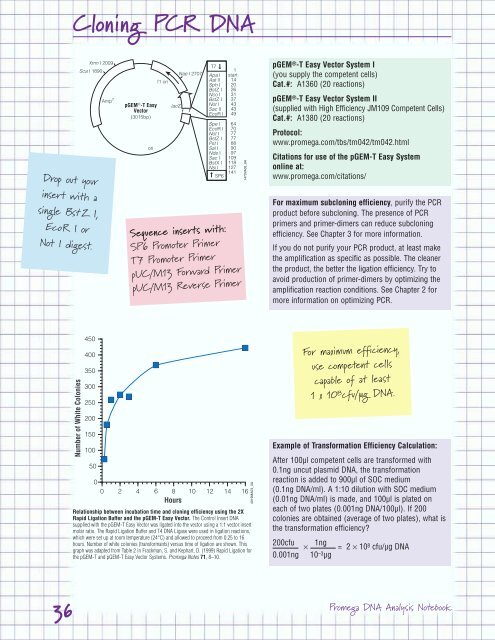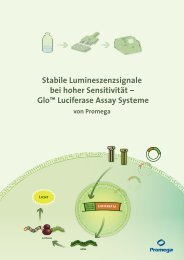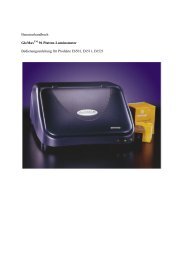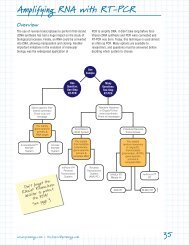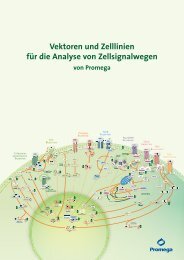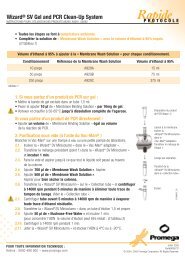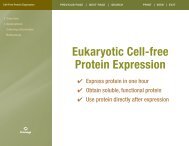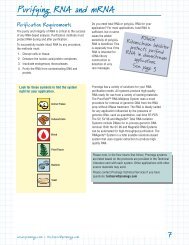DNA Analysis Notebook chapter: Cloning PCR DNA - Promega
DNA Analysis Notebook chapter: Cloning PCR DNA - Promega
DNA Analysis Notebook chapter: Cloning PCR DNA - Promega
You also want an ePaper? Increase the reach of your titles
YUMPU automatically turns print PDFs into web optimized ePapers that Google loves.
36<br />
<strong>Cloning</strong> <strong>PCR</strong> <strong>DNA</strong><br />
Sca I 1890<br />
Drop out your<br />
insert with a<br />
single Bst Z I,<br />
Eco R I or<br />
Not I digest.<br />
Number of White Colonies<br />
Xmn I 2009<br />
450<br />
400<br />
350<br />
300<br />
250<br />
200<br />
150<br />
100<br />
50<br />
Amp r<br />
pGEM ® -T Easy<br />
Vector<br />
(3015bp)<br />
ori<br />
f1 ori<br />
Nae I 2707<br />
lacZ<br />
T T<br />
Apa I<br />
Aat II<br />
Sph I<br />
BstZ I<br />
Nco I<br />
BstZ I<br />
Not I<br />
Sac II<br />
EcoR I<br />
Spe I<br />
EcoR I<br />
Not I<br />
BstZ I<br />
Pst I<br />
Sal I<br />
Nde I<br />
Sac I<br />
BstX I<br />
Nsi I<br />
Relationship between incubation time and cloning efficiency using the 2X<br />
Rapid Ligation Buffer and the pGEM-T Easy Vector. The Control Insert <strong>DNA</strong><br />
supplied with the pGEM-T Easy Vector was ligated into the vector using a 1:1 vector:insert<br />
molar ratio. The Rapid Ligation Buffer and T4 <strong>DNA</strong> Ligase were used in ligation reactions,<br />
which were set up at room temperature (24°C) and allowed to proceed from 0.25 to 16<br />
hours. Number of white colonies (transformants) versus time of ligation are shown. This<br />
graph was adapted from Table 2 in Frackman, S. and Kephart, D. (1999) Rapid Ligation for<br />
the pGEM-T and pGEM-T Easy Vector Systems. <strong>Promega</strong> Notes 71, 8–10.<br />
T7<br />
➞<br />
➞<br />
SP6<br />
1<br />
start<br />
14<br />
20<br />
26<br />
31<br />
37<br />
43<br />
43<br />
49<br />
64<br />
70<br />
77<br />
77<br />
88<br />
90<br />
97<br />
109<br />
118<br />
127<br />
141<br />
Sequence inserts with:<br />
SP6 Promoter Primer<br />
T7 Promoter Primer<br />
pUC/M13 Forward Primer<br />
pUC/M13 Reverse Primer<br />
0<br />
0 2 4 6<br />
8<br />
Hours<br />
10 12 14 16<br />
1473VA05_6A<br />
4019MA03_3A<br />
pGEM ® -T Easy Vector System I<br />
(you supply the competent cells)<br />
Cat.#: A1360 (20 reactions)<br />
pGEM ® -T Easy Vector System II<br />
(supplied with High Efficiency JM109 Competent Cells)<br />
Cat.#: A1380 (20 reactions)<br />
Protocol:<br />
www.promega.com/tbs/tm042/tm042.html<br />
Citations for use of the pGEM-T Easy System<br />
online at:<br />
www.promega.com/citations/<br />
For maximum subcloning efficiency, purify the <strong>PCR</strong><br />
product before subcloning. The presence of <strong>PCR</strong><br />
primers and primer-dimers can reduce subcloning<br />
efficiency. See Chapter 3 for more information.<br />
If you do not purify your <strong>PCR</strong> product, at least make<br />
the amplification as specific as possible. The cleaner<br />
the product, the better the ligation efficiency. Try to<br />
avoid production of primer-dimers by optimizing the<br />
amplification reaction conditions. See Chapter 2 for<br />
more information on optimizing <strong>PCR</strong>.<br />
Example of Transformation Efficiency Calculation:<br />
After 100µl competent cells are transformed with<br />
0.1ng uncut plasmid <strong>DNA</strong>, the transformation<br />
reaction is added to 900µl of SOC medium<br />
(0.1ng <strong>DNA</strong>/ml). A 1:10 dilution with SOC medium<br />
(0.01ng <strong>DNA</strong>/ml) is made, and 100µl is plated on<br />
each of two plates (0.001ng <strong>DNA</strong>/100µl). If 200<br />
colonies are obtained (average of two plates), what is<br />
the transformation efficiency?<br />
200cfu × 1ng<br />
0.001ng 10 –3 µg<br />
For maximum efficiency,<br />
use competent cells<br />
capable of at least<br />
1 x 10 8 cfu/µg <strong>DNA</strong>.<br />
= 2 × 10 8 cfu/µg <strong>DNA</strong><br />
<strong>Promega</strong> <strong>DNA</strong> <strong>Analysis</strong> <strong>Notebook</strong>


